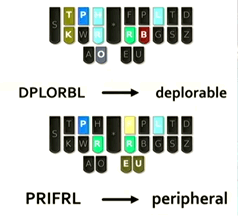
Ever seen one of these badboys? This was some serious state-of-the-art tech in 1912 — the stenotype machine.
If you haven’t come across one in real-life, you’ve most likely seen them in TV or movies. In courtroom dramas there’s often a primly-dressed woman to one side quietly tapping away at what looks like a baby typewriter.
Stenography is still a specialist skill that requires significant training and practice to master, but that is still in high demand.
The stenotype machine has just 22 keys and no spacebar. Rather than typing each letter to build a word, stenographers use key combinations — much like chords on a piano — that can trigger much longer words.

Originally stenographers produced rolls of coded shorthand that were later manually converted to plain text. Today’s more advanced machines handle the conversion in realtime.
Beside court reporting, stenographers are often used in live captioning of television, as well as other general business situations.
While there are friction points to learning stenography, there’s a good reason why stenographers take on the expensive tuition fees, the steep learning curve and the overpriced hardware (top-end machines are over $4,000).
Stenography is fast. Really fast.
A good stenographers can cruise along at 240 words per minute with 99.9% accuracy. That’s a single mistake every four pages.
Ok. And I care…, why?
About four years ago, stenographer Mirabai Knight came to the conclusion that stenography had been a walled garden for too long — controlled and marginalized by big companies. She set about creating her own affordable hardware and open source sofware designed to set stenography free to the masses.
This system — called Plover — can be used by book authors, journalists, bloggers and — importantly for us — coders and developers in our daily work!
In a demo, Mirabai showed she was able to take 140 keystrokes of Python and reproduce it with steno in less than 50 keystrokes! Now, I know there are lots of ‘VIM ninjas’ out there that pride themselves on their supreme keyboard-fu skills, but I’d be surprised if they could touch that sort of efficiency.
Plover offers a set of laser-cut ‘keytoppers’ that mount directly on top of your keyboard. Note that this keyboard does need to be able to recognize multiple similtaneous keystrokes, so gaming keyboards (starting at $50) are the norm.
There are also a number of projects working on affordable standalone hardware solutions. Joshua Lifton is working on a beautiful, high-quality bamboo and aluminium prototype called the Stenosaurus. He’s looking to crowd fund its commercial production in the coming months through a CrowdSupply campaign.

Stenoboard is a kit that lets you construct your own stenotype unit from Arduinos and parts. You can even 3d print your own parts if you like. A basic kit with all parts will set you back about $200 (ex. shipping).
The software component of Plover is free, open source, and Python-based, so you should be able to get it working on most systems.
If you’re intrigued, last year Mirabai gave a great talk covering Plover that I’ve included here (runs around 30 minutes).
Learning Curves
While the startup costs are much reduced, the learning curve is certainly still there. Mirabai estimates it may take 2-3 months of practice to replicate your current QWERTY typing speeds.
After that you should keep getting faster each month for the next 2-6 years, when you’ll hit your top speed.
I think that’s a worthwhile return on your time investment.
Republished from the SitePoint Design Newsletter
Frequently Asked Questions (FAQs) about Writing Code Faster
What is the importance of understanding the problem before writing code?
Understanding the problem before writing code is crucial. It helps you to identify the requirements and constraints of the problem, which in turn guides you in writing efficient and effective code. Without a clear understanding of the problem, you may end up writing code that doesn’t solve the problem or is unnecessarily complex. It’s like trying to build a house without a blueprint. You need to know what you’re building before you start.
How can I improve my typing speed for faster coding?
Improving your typing speed can significantly enhance your coding speed. You can use online tools and software to practice and improve your typing speed. Regular practice, proper hand positioning, and learning keyboard shortcuts can also help increase your typing speed.
How does understanding the programming language syntax help in coding faster?
Understanding the syntax of a programming language is like knowing the grammar of a spoken language. It helps you to write code correctly and efficiently. If you’re familiar with the syntax, you can write code without constantly referring to documentation or tutorials, which can slow down your coding process.
How can using code snippets speed up my coding process?
Code snippets are reusable pieces of code that you can insert into your code. They can save you time by reducing the amount of code you have to write from scratch. Many code editors and IDEs support code snippets, and there are also online repositories where you can find snippets for various programming languages and tasks.
How can planning my code in advance help me code faster?
Planning your code in advance can help you identify potential issues and solutions before you start coding. It allows you to structure your code effectively and reduces the time spent on debugging and rewriting code. You can plan your code using pseudocode or flowcharts.
How can regular breaks improve my coding speed?
Regular breaks can help prevent burnout and maintain your focus and productivity. They give your brain a chance to rest and process information. The Pomodoro Technique, which involves working for 25 minutes and then taking a 5-minute break, is a popular method for managing work and break times.
How can learning and using keyboard shortcuts speed up my coding process?
Keyboard shortcuts can significantly speed up your coding process by reducing the time spent on navigating and performing actions in your code editor or IDE. They allow you to perform common tasks, like copying and pasting code, opening and closing files, and navigating between lines and files, without using your mouse.
How can using a good code editor or Integrated Development Environment (IDE) help me code faster?
A good code editor or IDE can greatly enhance your coding speed and productivity. They provide features like syntax highlighting, code completion, error detection, and debugging tools, which can help you write, test, and debug your code more efficiently.
How can mastering a single programming language help me code faster?
Mastering a single programming language allows you to write code more efficiently and effectively. It enables you to understand and use advanced features and techniques of the language, which can help you solve problems more quickly and write better code.
How can collaborating with others help me code faster?
Collaborating with others can help you code faster by allowing you to learn from others, get feedback on your code, and solve problems together. It can also help you stay motivated and focused. You can collaborate with others through pair programming, code reviews, and online coding communities.
 Alex Walker
Alex WalkerAlex has been doing cruel and unusual things to CSS since 2001. He is the lead front-end design and dev for SitePoint and one-time SitePoint's Design and UX editor with over 150+ newsletter written. Co-author of The Principles of Beautiful Web Design. Now Alex is involved in the planning, development, production, and marketing of a huge range of printed and online products and references. He has designed over 60+ of SitePoint's book covers.
